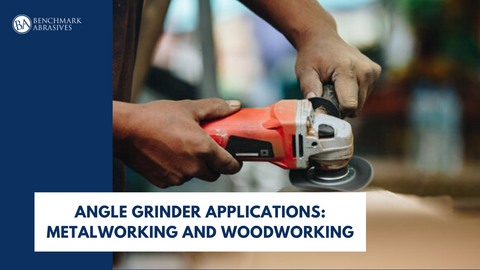
Angle Grinder Applications: Metalworking and Woodworking

One of the most useful and necessary tools in every shop is the angle grinder, sometimes known as the right-angle grinder. Operating at high RPMs, it uses a geared head to efficiently rotate various abrasive discs. Unlike stationary tools, its portability and superior grinding precision make it necessary for tasks ranging from aggressive metal cutting to delicate wood carving. With the right attachments, your angle grinder can handle grinding, cutting, cleaning, and polishing across metal and wood.
An Angle Grinder: What is it?
An angle grinder is a compact, portable power tool that uses a geared head to quickly rotate a disc or other attachment. Other names for these instruments are "disc grinders" and "side grinders." For accurate control, they have a side handle, a guard, and a main body. The more discs and attachments you have, the more useful your angle grinder becomes.
Grinder Sizes
Angle grinders are primarily sized by their maximum disc diameter:
- 4.5-inch (115mm): The most common and versatile size, ideal for DIY and everyday metal/wood applications.
- 7-inch and 9-inch: Larger, heavier, and more powerful models used for heavy industrial cutting and concrete work.
Safety First: Essential Gear
Given the high RPMs (often exceeding 10,000 RPM) and the volume of sparks and debris generated, safety is non-negotiable when using an angle grinder.
- Full Face Shield: Mandatory—eye protection alone is insufficient. Sparks, wire fragments, and grit can ricochet toward the face.
- Hearing Protection: The high-speed rotation generates significant noise. Earmuffs or earplugs should always be worn to prevent long-term hearing damage.
- Heavy Gloves: Provides essential protection from sharp metal edges, heat, and vibration, as well as a more secure grip on the tool.
- Fire Prevention: Ensure no flammable materials are near the spark path when cutting or grinding metal.
Angle Grinder Applications in Metalworking
These grinders excel at challenging metalworking projects, from simple grinding and cutting to delicate tasks like cleaning and polishing. The diverse uses truly come to life when paired with special attachments.
| Metalworking Task | Attachment Used | Primary Goal |
| Grinding | Grinding Wheel or Flap Disc | Shaping metal, smoothing heavy weld beads. |
| Cutting | Thin Cut-Off Wheel | Fast cutting bolts, pipes, or metal. |
| Polishing | Polishing Disc/Pad and Compound | Finishing metals to the desired luster or gloss. |
| Cleaning | Wire Wheel or Strip Disc | Removing loose metal, scale, or surface contaminants. |
- Grinding Metal: You can easily shape metal using a rigid grinding wheel or an abrasive flap disc. The flap disc is preferred for achieving the desired finish while simultaneously removing material.
- Cutting Metal: Using the proper cutting disc (thin cut-off wheel), angle grinders can quickly slice through most bolts, rods, or pipes.
- Cleaning Metal: A simple wire wheel or a braided wire cup brush can quickly remove rust, loose metal, and slag from a workpiece.
- Polishing Metal: The grinder's high RPMs are perfect for buffing. Outfitting your grinder with a polishing pad and compound makes quick work of finishing touches.
- Blending: Tools like surface conditioning discs simplify the blending and refining of metal. These are ideal for removing minor flaws, weld discoloration, or feathering the edge of a finished weld.
- Metal Rust And Paint Removal: A stripping wheel (made of abrasive synthetic fibers) easily and safely removes rust and old paint from various metals without being overly aggressive on the underlying material.
- Removing Mill Scale: This hard iron oxide is a challenge for any metalworking project.
- Deburring Metal: Irregularities or ridges (burrs) are commonly produced by machining processes. Metalworkers manually remove these using an appropriate disc or wheel to maintain product quality.
Angle Grinder Applications in Woodworking
Angle grinders can be used in a few different ways to effortlessly shape projects and cut through wood. Due to the tool's high power and RPM, it is generally not advised for fine, sensitive work.
Warning: High Kickback Risk
Extreme caution is required in woodworking. Aggressive carving discs can easily catch the wood grain and cause severe kickback, leading to a loss of control. Always secure your workpiece firmly and maintain a solid stance.
- Wood Carving: Carving discs (often similar to mini chainsaws or toothed wheels) are an efficient way of carving larger wooden items. Angle grinders are excellent for rough shaping, such as creating table legs or other large furniture components, but are not suitable for detailed, complex woodwork.
- Planing Wood: Similar to carving, a carving wheel can be used to quickly remove material for initial planing activities, acting as a rapid, aggressive alternative to a traditional wood plane.
- Sanding Wood: Abrasive sanding discs (often held by a backing pad) can be used for rough-sanding wood surfaces. You may easily work toward the desired finish, though the high RPM demands care to avoid creating gouges or burn marks.
Angle Grinders are Essential in Different Industries.
Angle grinders are indispensable in many trades, often due to their ability to cut and grind hard materials like stone and masonry.
- Masonry and Tile Cutting: When fitted with a diamond blade, angle grinders are highly effective at cutting ceramic, porcelain, and stone tiles to size.
- Tuckpointing: This is a specialized masonry application. Using a dedicated tuckpointing blade (a thick, segmented diamond wheel), angle grinders are used to safely and quickly remove old, deteriorating mortar from between bricks before new mortar is applied.
- Auto Bodywork: Essential for cutting out rusty metal panels and grinding welds smooth.
- Welding and Fabrication: Critical for joint prep, cleaning slag, and finishing welds.
- Knifemaking and Tool Sharpening: Used for rough shaping and grinding edges.
An angle grinder is one of the most practical and efficient tools you can own if you have the appropriate accessories and discs.



































































